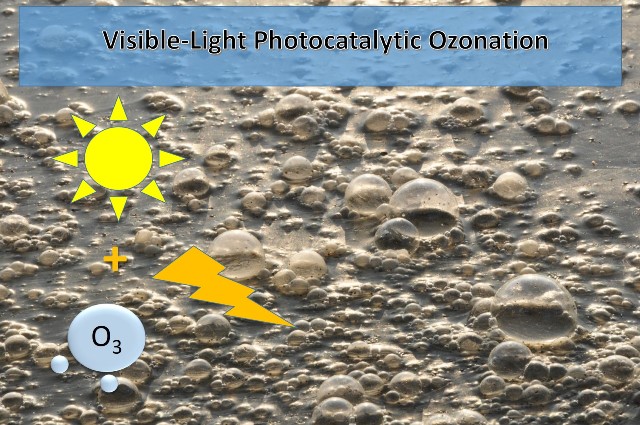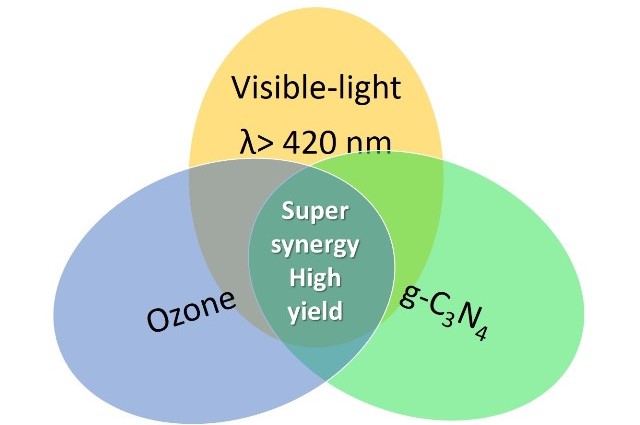A photocalytic wastewater treatment with sunlight and ozone
As we know, water contamination is a serious environmental problem, and if we talk about contamination by compounds derived from drug residues the panorama is even worse, since they are made up of complex substances that are difficult to eliminate using conventional means of treatment. This is why many laboratories are working on photocatalytic solutions, which have demonstrated over the last two decades a robust oxidation capacity and a great potential for practical wastewater treatment using sunlight and air (as a source of ozone).

New procedure for wastewater treatment. Source: image designed by @emiliomoron, contains public domain image.
However, the development of this technology has been limited mainly by the lack of catalysts that can operate under visible light and unclear reasons that underlie its high hydroxyl radical (-OH) yield. But scientists at the Leibniz Institute for Catalysis in Rostock have made a breakthrough in substantially solving these questions, and have discovered the molecular mechanism of a photocatalyst that completely breaks down organic contaminants in wastewater with the help of sunlight. In their report presented in ACS publications they have summarized their contributions, among them: new generation graphitic carbon nitride catalysts with excellent performance for photocatalytic ozonation under visible light.
This represents a great advance and clears the horizon for the development of photocatalytic treatment of wastewater, especially for densely populated populations or with the presence of pharmaceutical industries, where the incorporation of drug degradation products in wastewater is a major problem.
Carbonitride as a new catalyst
Titanium dioxide is conventionally used as a catalyst in these processes, since it works very efficiently in the decomposition of polluting particles using high-energy UV radiation. However, it is not possible to use them with sunlight, since the proportion of UV rays in sunlight is too low for this. Therefore, a new generation of photocatalysts was needed, and the carbon nitride showed to be activated by visible light, which is almost 50% of the sun's energy.
The research group was able to successfully test this catalyst with various substances that are produced during drug degradation and that reach the wastewater. The scientists added the catalyst by adding it in powder form to the water, and tested oxygen and ozone as oxidizing agents, finding that the catalyst did its job well while suspended in solution and demonstrating that the ozone was extraordinarily effective.
The carbonitride used as a catalyst, named g-C3N4 in bulk and nanoporous triggers a strong synergy between visible light and ozone, causing an efficient mineralization of a wide variety of organic pollutants. Using the g-C3N4 in photocatalytic ozonization, the mineralization of oxalic acid (a model pollutant) is obtained at a rate 95.8 times higher than photocatalytic oxidation with oxygen.

New catalyst triggers strong synergy between visible light and ozone. Image designed by @emiliomoron.
The result of the research work is an important advance for this type of reaction, which is already necessary in practice, since many drugs are persistent in the environment, being resistant to conventional processes of wastewater regeneration. Many treatment plants worldwide have considered new treatment strategies such as the modification of operating conditions (solids retention time, temperature), but the implementation of new technologies such as the installation of advanced post-treatment units like the oxidation process described, are a promising option for the removal of these microcontaminants.
Thanks for coming by to read friends, I hope you liked the information. See you next time.

This post has been manually curated by @bala41288 from Indiaunited community. Join us on our Discord Server.
Do you know that you can earn a passive income by delegating to @indiaunited. We share 80 % of the curation rewards with the delegators.
Here are some handy links for delegations: 100HP, 250HP, 500HP, 1000HP.
Read our latest announcement post to get more information.
Please contribute to the community by upvoting this comment and posts made by @indiaunited.
Many thanks!
@tipu curate 6
Upvoted 👌 (Mana: 100/250) Liquid rewards.
Thank you very much for your support!!
El desarrollo de ideas es excelente cuando interviene la acción para dar forma a ellas...saludos
Hola @mercmarg. Así es, lo más importante es pasar a la acción para darle forma a las ideas, gracias por pasar por mi blog. Saludos.
Little, or rather almost nothing I know about catalytic reaction, this employing photocatalysis in the decontamination of water, sounds quite an environmentally friendly practice.
For the good of humanity, we hope that soon, the researchers involved make significant progress, and that we can see rapid effects. Thanks friend @emiliomoron, for sharing this kind of content.
Greetings friend @lupafilotaxia, If it is even better for the environment, because you can use the sun as a source of light for the reaction, since with other catalysts that are activated with UV rays this radiation must be supplied and you consume energy. Let's hope to see progress in this area very soon.
Good article, one of the things that comes to mind about this catalyst is whether it will have a long-term adverse effect.
Greetings friend. We would have to wait for toxicity tests, however generally the hetererogeneous catalysts can be easily recovered from the solutions.
Greetings friend @emiliomoron.
Water pollution is one of the biggest problems we can have, apart from the contamination by compounds derived from medicine residues, that is something that will make us worse environmentally.
It would be a great help if the laboratories are working on possible solutions for the not too distant future, because if working with photocatalytic is a welcome solution.
Greetings and thanks for this important article.
Greetings @sandracarrascal. Really the laboratories must put interest in this matter, and the people in general also, since many of these products are eliminated also by us.
As usual another excellent contribution in this occasion related to the photocatalytic treatment of wastewater with sunlight and bear, this practice is projected as an interesting method for decontamination of water hopefully consolidated, thanks for continuing to educate us about it.
Greetings friend @rbalzan79. Thanks to you for the assessment of the article, let's hope the technology matures and reaches its implementation, as it looks promising.